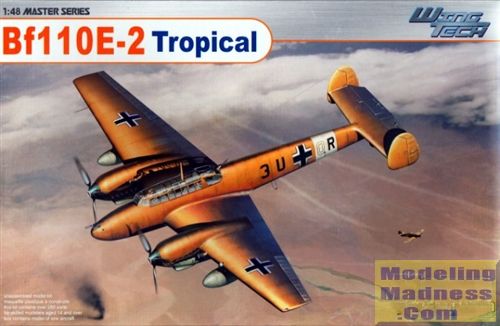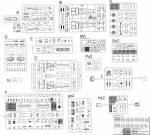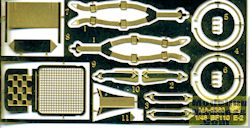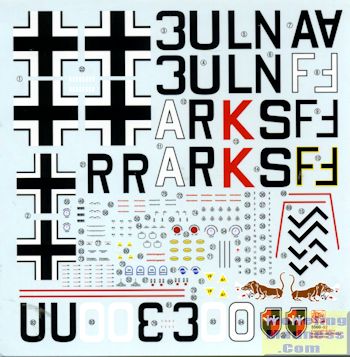
CyberHobby 1/48 Bf-110E-2/trop
| KIT #: | 5560 |
| PRICE: | $62.00 MSRP |
| DECALS: | Three options + |
| REVIEWER: | Scott Van Aken |
| NOTES: | Wing Tech boxing |

| HISTORY |
The Messerschmitt Bf 110, called Me 110, was a twin-engine heavy fighter (Zerstörer - German for "Destroyer") in the service of the Luftwaffe during World War II. Hermann Göring was a proponent of the Bf 110, and nicknamed it his Eisenseiten ("Ironsides"). Development work on an improved type, the Me 210 that was to replace the Bf 110, begun before the war started, but due to teething troubles, resulted in Bf 110 soldiering on until the end of the war in various roles, alongside its replacements, the Me 210 and the Me 410.
The Bf 110 served with success in the early campaigns, the Polish, Norwegian and Battle of France. The Bf 110's lack of agility in the air was its primary weakness. This flaw was exposed during the Battle of Britain, when some Bf 110 equipped units were withdrawn from the battle after very heavy losses and redeployed as night fighters, a role to which the aircraft was well suited. The Bf 110 enjoyed a successful period following the Battle of Britain as an air superiority fighter and strike aircraft in other theatres. During the Balkans Campaign, North African Campaign and the Eastern Front it rendered valuable ground support to the German Army as a potent fighter-bomber (Jagdbomber-Jabo). Later in the war, it was developed into a formidable night fighter, becoming the major night-fighting aircraft of the Luftwaffe. Most of the German night fighter aces flew the Bf 110 at some point during their combat careers, and the top night fighter ace of all times, Major Heinz-Wolfgang Schnaufer, flew it exclusively, and claimed 121 victories in 164 combat missions.
The Bf-110E was an upgraded D variant with more powerful engines and additional strengthening to allow it to carry more ordnance. It retailed the elongated tail of the D-3 version, though did away with the large fuel tanks. Thanks to the increased weight of the aircraft, it was the least liked version of the 110 and pilots who had flown earlier variants felt it was sluggish and unresponsive. As with most Luftwaffe aircraft, there were tropicalized versions that had sand filters and larger cooler radiators as well as a survival kit.
| THE KIT |
 This
has to be at least the fifth boxing of the Bf-110C/D/E series that Cyber-hobby
has produced and I'm sure there are still others to come as they seem to
concentrate on sub-variants for their boxings. The kit is not light on parts
with over 280 bits listed on the box cover.
This
has to be at least the fifth boxing of the Bf-110C/D/E series that Cyber-hobby
has produced and I'm sure there are still others to come as they seem to
concentrate on sub-variants for their boxings. The kit is not light on parts
with over 280 bits listed on the box cover.  tor's
seat is also photo etch. A full radio suite as well as access to the lower
fuselage forward firing guns is also part of the kit. A rear gun as spare
ammunition cases are also provided. There is plenty of detail in the sidewalls
as well. In fact, this kit is pretty much a scaled down version of their 1/32
kit, though with fewer tiny bits.
tor's
seat is also photo etch. A full radio suite as well as access to the lower
fuselage forward firing guns is also part of the kit. A rear gun as spare
ammunition cases are also provided. There is plenty of detail in the sidewalls
as well. In fact, this kit is pretty much a scaled down version of their 1/32
kit, though with fewer tiny bits.  that are part
of the fuselage assembly. While there is a center fuselage bomb rack in the
parts, it is not part of the build. Check your references to see if the plane
you are modeling has this feature or not before construction.
that are part
of the fuselage assembly. While there is a center fuselage bomb rack in the
parts, it is not part of the build. Check your references to see if the plane
you are modeling has this feature or not before construction. | CONCLUSIONS |
| REFERENCES |
http://en.wikipedia.org/wiki/Bf_110
If you would like your product reviewed fairly and quickly, please contact me or see other details in the Note to Contributors.
Back to the Previews Index Page